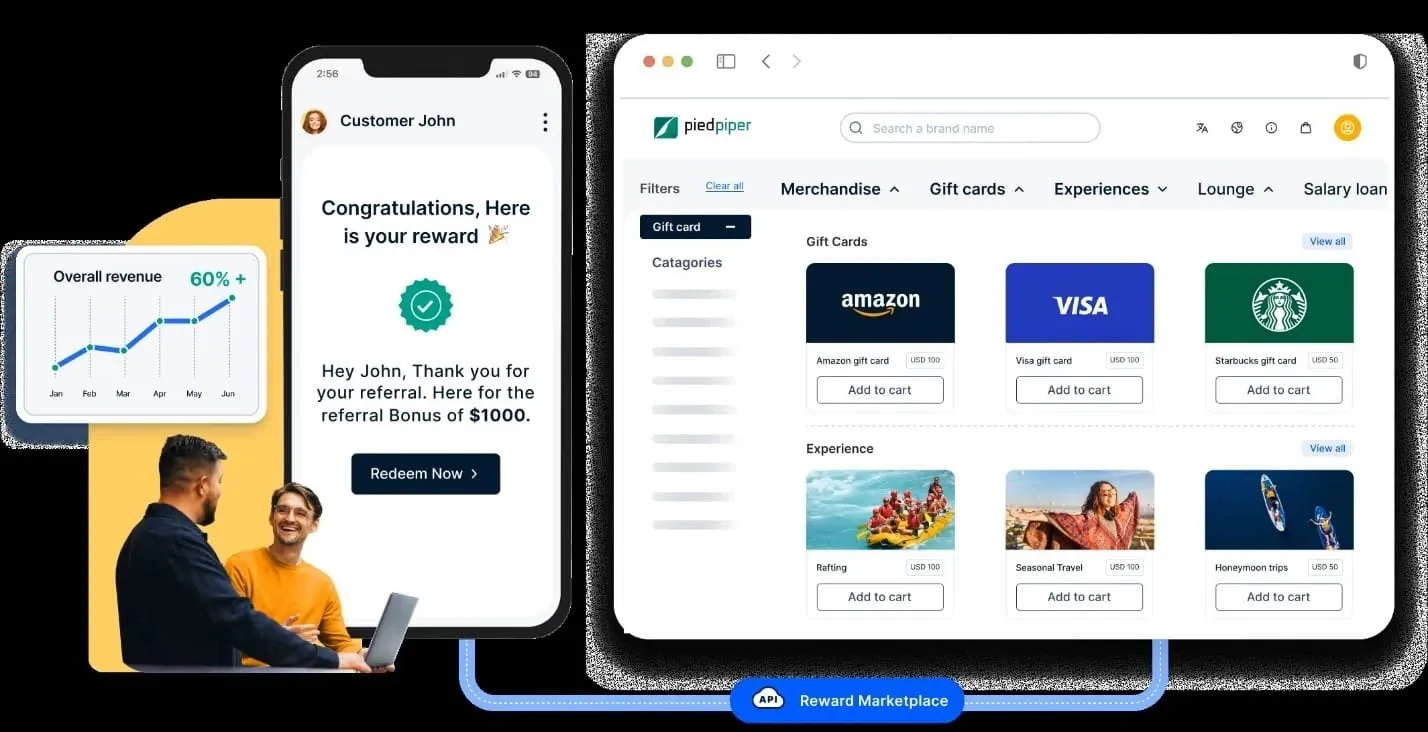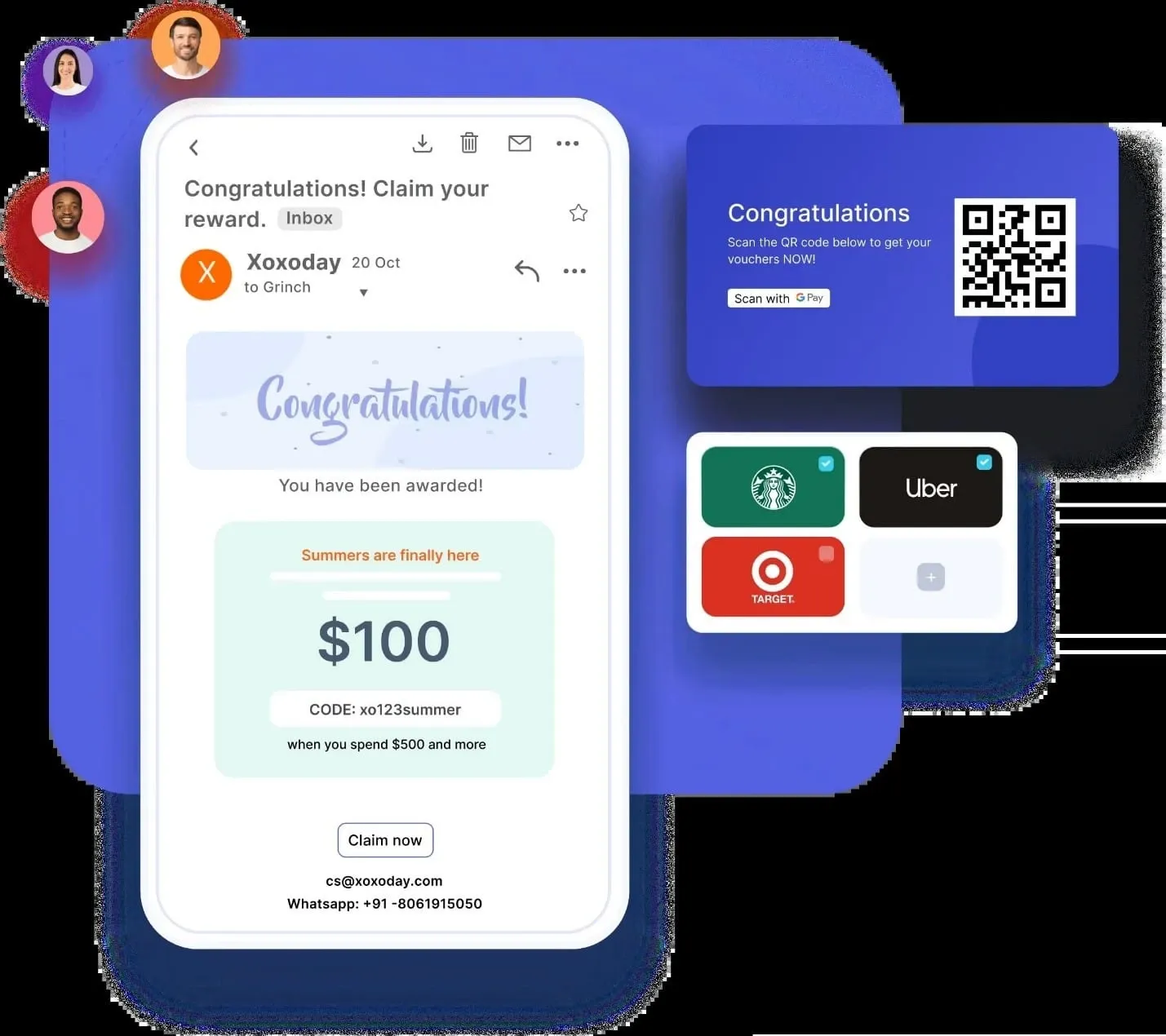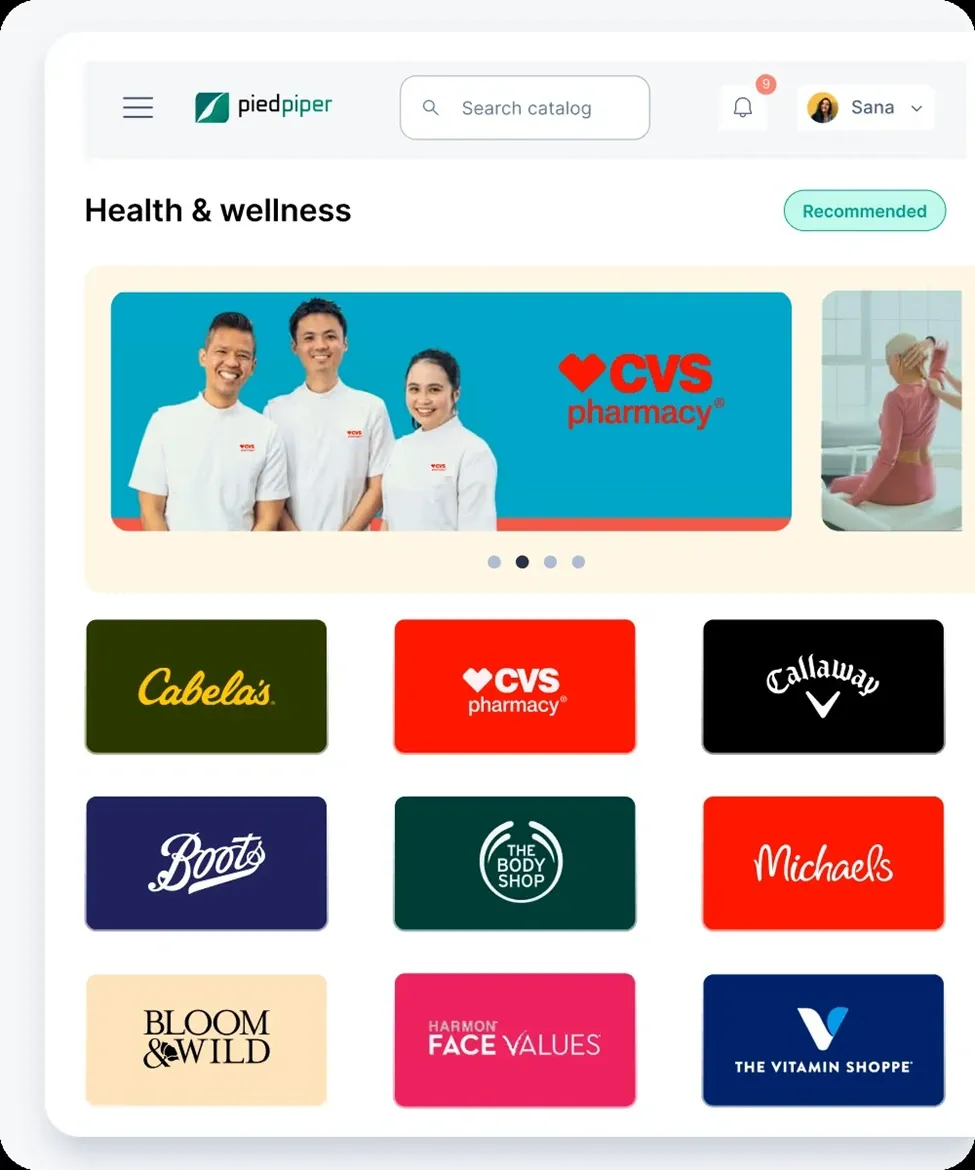Premios e incentivos para las empresas digitales de la nueva era
Las empresas digitales de la nueva era se enfrentan a un aumento de los costes de adquisición, una retención efímera y un bajo nivel de compromiso. Este blog explora cómo las recompensas e incentivos digitales estratégicos pueden hacer frente a estos retos, con ejemplos reales, ideas por categorías y perspectivas prácticas.
En esta página
- What are digital rewards and incentives?
- Retos de las empresas digitales de la nueva era
- Cómo las recompensas y los incentivos pueden afrontar los retos de las empresas digitales de la nueva era
- What kind of digital rewards and incentives can be offered?
- How to choose the right digital incentives?
- Revamping employee recognition: H&M's partnership with Xoxoday
- Conclusión
El panorama digital evoluciona constantemente, y las empresas digitales de la nueva era están a la vanguardia. Estas empresas, nacidas a menudo en la era de Internet y la tecnología móvil, se caracterizan por sus modelos de negocio innovadores, sus planteamientos basados en datos y sus rápidas trayectorias de crecimiento.
Operan en un entorno hipercompetitivo en el que la captación de clientes es cara, la retención es efímera y el compromiso es crucial para el éxito.
Destacar en este mercado digital saturado exige planteamientos estratégicos e innovadores para atraer a nuevos clientes, mantener el compromiso de los existentes y fomentar la fidelidad a la marca. En este contexto, las recompensas y los incentivos surgen como poderosas herramientas para ayudar a las empresas digitales de la nueva era a alcanzar sus objetivos.
Estas empresas pueden ofrecer estratégicamente recompensas e incentivos para motivar y fomentar los comportamientos deseados de los clientes, impulsar el compromiso y lograr una ventaja competitiva sostenible.
Esta entrada de blog explorará los retos a los que se enfrentan las empresas digitales de la nueva era y cómo se pueden utilizar eficazmente los premios e incentivos para hacer frente a estos retos. También explorará ejemplos reales de implementación exitosa de recompensas e incentivos, analizará estrategias reales para la adquisición, retención y compromiso de los clientes, y explorará perspectivas sobre el futuro de las recompensas y los incentivos en la era digital.
What are digital rewards and incentives?
Digital rewards are exactly what the name suggests—perks or incentives delivered digitally instead of in a physical form. The most widely used digital rewards are digital gift cards, which recipients can redeem online and use either at physical stores, restaurants, or on the brand’s website.
Virtual prepaid cards, such as Visa or MastercardⓇ, provide even greater flexibility since they can be used across various retailers, not just one.
Other forms of digital incentives include charitable donations, virtual event tickets, discount coupons, downloadable media, promo codes, gated content access, virtual achievement badges, and digital items like eBooks or premium articles.
What unites all these rewards is their ease of delivery—there’s no need for shipping or handling. They can be sent directly via email, SMS, or through a personalized link on your website or company portal.
Among all options, digital gift cards remain a top favorite for their flexibility and broad appeal, letting recipients choose their own reward from popular brands like Amazon, eBay, Walmart, Target, Wayfair, and more.
Retos de las empresas digitales de la nueva era
Estos son los retos a los que se enfrentan las empresas digitales de la nueva era:
1. Alto coste de adquisición de clientes (CAC)
Las empresas digitales de la nueva era luchan constantemente contra el creciente coste de captar nuevos usuarios. Los canales tradicionales de marketing y publicidad, antaño considerados fiables, están cada vez más saturados y resultan más caros.
Esto se agrava aún más:
- Puja ciega: Plataformas como las redes sociales utilizan sistemas de subasta, lo que da lugar a una feroz competencia por la atención de los usuarios, en la que el mejor postor suele ganar el espacio publicitario.
- Ceguera ante los banners: Los usuarios están cada vez más acostumbrados a ignorar los anuncios en línea, lo que hace que muchos banners tradicionales sean ineficaces.
- Clics fraudulentos: La presencia de clics fraudulentos y de actividad de bots puede inflar los costes publicitarios sin ofrecer clientes potenciales reales.
Estos factores contribuyen a un elevado coste de adquisición de clientes (CAC), por lo que es crucial que las empresas digitales de la nueva era encuentren formas innovadoras y rentables de llegar a nuevos clientes.
2. Baja retención de usuarios
Incluso después de conseguir nuevos usuarios, la batalla está lejos de terminar. Las empresas digitales de la nueva era se enfrentan al reto de la baja retención de usuarios. Varios factores pueden contribuir a la pérdida de usuarios, entre ellos:
- Falta de diferenciación: En un mercado digital saturado, destacar requiere una propuesta de valor clara y diferenciarse de la competencia. Los usuarios que perciben que otra empresa ofrece un producto o servicio mejor son más propensos a cambiar.
- La competencia: La afluencia constante de nuevos actores que compiten por la atención de los usuarios amplifica el reto de la retención. Los usuarios tienen innumerables opciones y las empresas deben esforzarse continuamente por ofrecer un valor excepcional para retener a su base de usuarios.
- Bajo valor percibido: Si los usuarios no perciben el producto o servicio de la empresa como lo suficientemente valioso como para justificar su uso continuado, es más probable que se den de baja. Esto puede deberse a la falta de funciones, a una experiencia de usuario deficiente o a expectativas no cumplidas.
Abordar estos factores e involucrar a los usuarios para crear valor y apego es esencial para que las empresas digitales de la nueva era mejoren la retención de usuarios y maximicen el valor del ciclo de vida del cliente (LTV).
3. Poco compromiso de los usuarios
Más allá de la mera adquisición y retención de usuarios, para las empresas digitales de la nueva era es crucial fomentar altos niveles de participación de los usuarios. Sin embargo, esto plantea sus propios retos:
- Poca capacidad de atención: en el mundo digital actual, los usuarios tienen menos capacidad de atención y se distraen fácilmente con aplicaciones, plataformas y contenidos de la competencia.
- Falta de propósito: si los usuarios no ven un propósito claro en el uso de la plataforma o no entienden cómo añade valor a sus vidas, es menos probable que participen de forma constante.
- Complejidad y fricción: Las interfaces de usuario complejas o las funcionalidades engorrosas pueden disuadir a los usuarios de participar con regularidad.
4. 4. Motivación de los empleados
The fast-paced, high-growth environment characteristic of new-age digital companies also presents challenges related to employee motivation. Here are some key aspects to consider:
- Agotamiento y estrés: La naturaleza exigente del trabajo puede provocar agotamiento y estrés en los empleados, lo que repercute negativamente en la productividad y el bienestar general.
- Déficit de competencias: A medida que las empresas evolucionan rápidamente y adoptan nuevas tecnologías, surge el riesgo de que se produzcan carencias de competencias, lo que exige una formación y un desarrollo continuos de los empleados para mantener la motivación y el compromiso.
- Elevada rotación de personal: En un mercado de talentos competitivo, la alta rotación de empleados puede ser perjudicial y provocar una pérdida de valiosos conocimientos institucionales.
Cómo las recompensas y los incentivos pueden afrontar los retos de las empresas digitales de la nueva era
En el despiadado mundo de las empresas digitales de la nueva era, donde la competencia es feroz y la atención del usuario fugaz, atraer a nuevos clientes, retener a los existentes y fomentar el compromiso es primordial.
But achieving these goals can be an uphill battle. This is where rewards and incentives come in, crucial in addressing the key challenges these companies face.
1. Adquisición de clientes
- Account-Based Marketing (ABM): It is a game-changer for customer acquisition. Unlike traditional methods that scatter a wide net, ABM focuses on a targeted list of high-value companies.
This focus allows for deep research and personalized messaging directly addressing each account's unique needs and challenges. By crafting content and rewards that resonates and building relationships with key decision-makers, ABM dramatically increases the chance of converting these ideal customers.
- Referral programs: Referral programs incentivize existing users to spread the word about your product or service by offering them rewards like discounts, points, or exclusive benefits for successful referrals. This leverages the power of word-of-mouth marketing and can significantly reduce customer acquisition costs (CAC). Over 9 in 10 consumers trust referrals from friends and family over anything else

- Welcome bonuses and trial periods: First impressions matter and offering welcome bonuses or free trials can be a great way to entice new users. These incentives act as a low-risk entry point for potential customers, allowing them to experience your offering firsthand before committing financially.
- Gamification: Implementing gamification elements like points, badges, and leaderboards can increase user engagement and serve as a subtle acquisition tool. These elements add a layer of fun and competition, encouraging users to take desired actions, ultimately leading to higher conversion rates. Gamification companies can see up to 7X higher conversion rates.
2. Retención de clientes
- Loyalty programs: Loyalty programs reward repeat customers for their continued patronage, creating a sense of value and appreciation. These programs can offer various benefits like points redeemable for rewards, exclusive discounts, or priority access to new features. According to 69% of consumers, loyalty programs influence their purchasing decisions.
- Beneficios por niveles: Lleve los programas de fidelización al siguiente nivel introduciendo niveles con ventajas crecientes. A medida que los usuarios se comprometen más y ascienden en los niveles, desbloquean recompensas mejoradas y ventajas exclusivas, lo que les incentiva aún más a mantenerse activos y fieles.
- Recompensas personalizadas: No todos los clientes son iguales. Adaptar las recompensas a las preferencias de cada usuario puede aumentar significativamente el impacto de su programa. Si aprovecha los datos sobre el comportamiento y las preferencias de los usuarios, podrá ofrecer recompensas personalizadas que se adapten a cada uno de ellos y les hagan sentirse valorados y apreciados.

3. Compromiso del usuario
- Points and rewards for actions: Encourage users to actively engage with your platform by rewarding them for specific actions. This could include completing tasks, purchasing, sharing content, or participating in discussions. By associating rewards with desired behaviors, you can nudge users towards more active engagement, ultimately increasing user lifetime value (LTV).
- Contests and giveaways: Inject some excitement and spark user participation through contests and giveaways. Offer attractive prizes like free products, exclusive experiences, or early access to new features. These events create a sense of buzz and encourage users to compete and interact, boosting overall engagement with your platform.
- Acceso anticipado y ofertas exclusivas: Haz que los usuarios se sientan especiales y valorados ofreciéndoles acceso anticipado a nuevas funciones, descuentos exclusivos o productos de edición limitada. Esto incentiva la participación y fomenta un sentido de comunidad y exclusividad, fortaleciendo el vínculo entre los usuarios y su marca.
4. 4. Motivación de los empleados
- Recompensas basadas en el rendimiento: Reconozca y recompense a los empleados por sus logros y contribuciones. La aplicación de recompensas basadas en el rendimiento, como bonificaciones, comisiones o reconocimientos públicos, puede aumentar considerablemente la motivación de los empleados e impulsarlos a luchar por la excelencia de forma constante.
- Reconocimiento social y premios: Reconozca y celebre públicamente los logros de los empleados mediante programas de premios o menciones. Esto motiva al individuo reconocido e inspira a otros a superarse, fomentando un fuerte sentido de trabajo en equipo y colaboración.
- Employee wellness programs: Prioritize your employees' well-being by offering wellness programs that focus on their physical and mental health. These programs can include gym memberships, mental health resources, or flexible work arrangements. Investing in their well-being creates a supportive and positive work environment, ultimately leading to increased employee motivation and satisfaction.

What kind of digital rewards and incentives can be offered?
Digital rewards can be grouped into categories that cater to various recipient preferences, from shopping and wellness to entertainment and social impact. Here's a breakdown of popular categories and top reward options within each:
Gift cards
These are flexible, universally appreciated rewards that allow recipients to choose what they want. They're ideal for personalizing the experience without overcomplicating the selection process.
- Amazon e-gift card – Ideal for shopping across a wide range of categories.
- Starbucks gift card – A perfect pick-me-up for coffee lovers.
Prepaid & wallet cards
Prepaid cards and wallet credits offer the freedom to spend on almost anything, making them a versatile reward. They’re convenient and widely accepted online and offline.
- Visa/MastercardⓇ virtual prepaid cards – Usable across online and offline stores.
- Paytm or PhonePe wallet credits – Convenient for mobile payments and everyday purchases.

E-commerce & retail rewards
Perfect for rewarding consumers or employees who enjoy online shopping. These rewards offer access to a variety of categories like fashion, electronics, and home goods.
- E-gift card – Great for everything from gadgets to groceries.
Wellness & lifestyle
Support the well-being of recipients with rewards that promote physical and mental health. These are great for encouraging self-care and healthier lifestyles.
- Fitness/gym subscription – For fitness classes, therapy, and overall wellness.
- Calm or headspace membership – For guided meditation and mental health support.
Entertainment & dining
Great for leisure-focused rewards, this category allows recipients to enjoy meals or relax with music and streaming content. A perfect way to enhance work-life balance.
- Spotify Premium gift card – Stream music without ads.
Charity & Purpose-Driven Rewards
These rewards help recipients contribute to meaningful causes, adding emotional value to the gifting experience. Ideal for brands that prioritize sustainability and social impact.
- Donation to a cause (e.g., education, health, environment) – Supports meaningful initiatives.
- Tree plantation in recipient’s name – A green and memorable gesture.

Learning & development
Fuel growth and curiosity with access to online learning platforms. These rewards help individuals upskill and invest in their personal and professional development.
- Udemy or Coursera gift card – Access thousands of online courses.
- LinkedIn learning subscription – Learn in-demand skills on the go.
How to choose the right digital incentives?
Choosing the right digital incentives involves understanding your audience, your goals, and the context in which the reward is being given. Here’s a practical framework to help you make the right choice:
1. Conozca a su público
Understanding your recipients is the first step. What motivates a millennial employee may not appeal to a senior executive or a B2B customer. Consider factors like age, location, job role, lifestyle, and preferences. The more relevant the reward, the more likely it is to be appreciated and redeemed.
2. Match the incentive to the goal
Every reward should align with the outcome you're aiming for. Are you trying to increase survey participation, boost employee morale, or improve customer retention? Tailor the incentive accordingly quick wins like gift cards work well for feedback, while long-term loyalty may call for experience-based or tiered rewards.
3. Offer choice and flexibility
One size doesn't fit all. Offering multiple reward options gives recipients the freedom to choose something they truly value. Multi-brand gift cards, digital marketplaces, or customizable reward links help maximize satisfaction and minimize the chances of rewards going unclaimed.
4. Ensure instant delivery and accessibility
Digital incentives should be easy to send and even easier to redeem. Look for rewards that can be delivered instantly via email, SMS, or link—especially for global recipients. Timely delivery ensures that the reward remains relevant and enhances the overall experience.
5. Stay within budget without sacrificing appeal
A good incentive doesn’t have to break the bank. Focus on perceived value—some low-cost digital rewards like premium content, subscriptions, or discount codes can be very effective. Set clear budgets and choose platforms that offer transparent pricing and tracking tools.
6. Align with brand values
Rewards should reflect your company’s identity and values. For example, if your brand emphasizes sustainability, offer green rewards like tree-planting donations or eco-friendly products. This strengthens brand recall and makes your gifting strategy more authentic and meaningful.
Revamping employee recognition: H&M's partnership with Xoxoday
H&M, a leading global fashion retailer with over 171,000 employees worldwide, is renowned for offering fashion and quality at the best price in a sustainable way. With operations spanning more than 73 locations and encompassing nine independent brands, H&M continually seeks innovative solutions to enhance its human resource initiatives and maintain a motivated workforce.
Challenges faced:
H&M's internally developed Human Resource Management System (HRMS) faced several challenges in effectively implementing employee rewards:
- Cash-based rewards: Employees received rewards in cash alongside their salaries, which were subject to a flat tax rate, reducing the actual reward value.
- Logistical complications: Coordinating reward distribution involved multiple teams, including salary processing, winners, and HR business partners, making the process cumbersome.
- Diminished value for on-site employees: For on-site employees, currency conversion rates and applicable taxes further decreased the reward's value, leading to dissatisfaction.
Solution by Xoxoday Plum:
To address these challenges, H&M implemented Xoxoday's points-based rewarding system, offering multiple reward options such as experiences, gift vouchers, and perks. This integration provided:
- Enhanced rewarding efficiency: Streamlined processes reduced interdepartmental coordination, leading to a significant increase in peer-to-peer and manager nominations.
- Simplified on-site rewarding: On-site employees could easily redeem localized rewards tailored to their interests and geographic location, enhancing participation.
- Tax-efficient rewards: Employees received the full reward value without flat tax deductions, ensuring the incentives were more meaningful.
Resultados
The implementation of Xoxoday's solution yielded remarkable outcomes:
- Increased participation: 52% of all employees were nominated in the last fiscal year, with 10% receiving awards, indicating heightened engagement.
- Positive employee feedback: Surveys revealed a majority of employees favored the new rewarding process, appreciating its simplicity and effectiveness.
- Operational efficiency: The HR team experienced reduced administrative burdens, allowing them to focus on other strategic initiatives.
By partnering with Xoxoday, H&M successfully transformed its employee rewards and recognition program, fostering a more engaged and motivated workforce.
Conclusión
The digital age hasn’t just changed how we work or shop—it’s rewired how people respond to value. Static rewards and one-size-fits-all perks don’t cut it anymore. What moves the needle today?
Thoughtfully timed, context-driven incentives that feel less like transactions and more like appreciation. In this new landscape, strategic rewards are no longer perks—they’re signals of respect, recognition, and relevance.
Xoxoday Plum makes this process seamless by automating the entire rewards journey—from selection to delivery. Whether you're incentivizing customers, recognizing employees, or delighting partners, Plum offers a global catalog of digital rewards, effortless integration with your existing tools, and detailed insights to optimize performance. Its flexibility, personalization, and scalability make it the go-to platform for modern businesses.
Ready to turn motivation into momentum?
Book a free demo with Xoxoday Plum today and build a rewards strategy that drives impact where it matters most.










